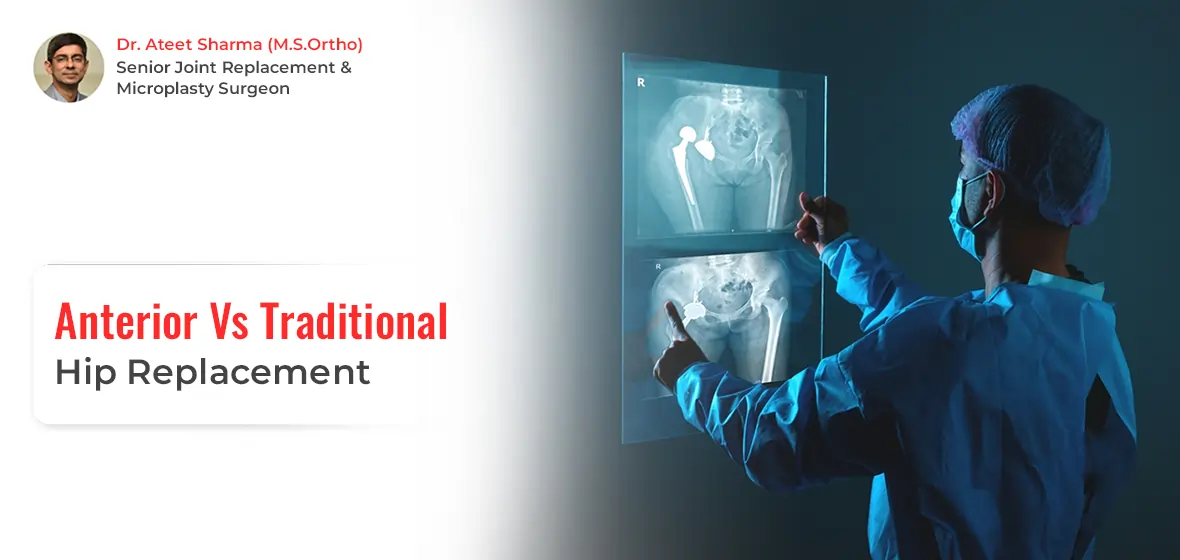
Hip Replacement Surgery is a procedure that can change the functioning and lifestyle of the suffering individual completely. It helps to gain relief from severe pain and discomfort that is caused by hip arthritis or any other cause. With the help of advancement in the medical field, the lack of mobility can be restored, allowing the patient to return to daily routine.
Choosing the right approach for Hip Replacement Surgery is crucial, as it can be a complex decision between Traditional Hip Replacement and the Anterior approach.
In this blog, we will compare Anterior and Traditional Hip Replacement with insights from Dr. Ateet Sharma, a Hip Replacement surgery specialist in Ahmedabad. It will help us understand their difference and when to consider which surgery.
Hip Replacement Surgery is a procedure that helps to replace a damaged joint of the hip with an artificial one. It helps in taking the place of the original joint. The overall objective of the surgery is to reduce pain and retain the routine to improve the lifestyle.
As the name suggests, this approach to Hip Replacement is been followed for years. Traditional Hip Replacement addresses various situations by operating on the back of the hip.

The size of the incision made is around 5-7 inches, depending upon the prevailing situation of an individual.
It helps get to the hip joint directly and provides a clear path for the surgeon to get a clean and clear vision for inserting instruments and any implants.
Position is one of the differences between the traditional and Anterior approaches. In the Traditional method, the patient position is "Side Profile." While the surgery is performed, surgeons have clear access to the back of the hip.
Padding tools ensure the patient's long-term comfort in this position. It also benefits the surgeon as it helps in correct alignment throughout the surgery.
The hip joint is dislocated, especially to reach the femoral head, also known as the ball and the acetabulum, known as the socket. Furthermore, the damaged parts are removed, and the new ones are implanted.
Here, the alignment must be proper for the success of the surgery and to ensure smooth mobility afterwards.
After the surgery, the surgeon stitches back the muscles to their original positions. Special care is taken while dealing with soft tissues to ensure quick healing.
The roots of the traditional method of Hip Replacement go back in time. It has been followed for many years, and thus, surgeons are well-educated and know about the procedure. It increases the success rate due to the long track of procedures being followed.
The risk of dislocation may arise if proper care is not maintained with time. This risk is in comparison with the Anterior approach. The risk of dislocation after surgery is higher than with the Anterior approach to Hip Replacement.
The recovery time is longer compared to other approaches as it takes time for the muscles to heal back and let the stitches recover that were caused due to the cuts.
Anterior Hip replacement Surgery is a modern approach to the medicine of Hip Replacement. With technological advancement and expert guidance, this approach makes the process easy and convenient for the patient.
In Anterior Hip Replacement, the incisions are small. Incisions made here are of 4 inches, which are less extensive compared to the traditional or posterior approach. It reduces the damage to surrounding tissues and leads to less recovery time after the surgery.
The patient is asked to lie on their back on the operating table. It provides clear access to the front hip area. While the surgery is going on, the whole team monitors various measurable signs, which helps ensure the patient's safety.
The damaged parts are removed, and new implants are placed. A new metal socket is placed in the pelvis. Durable plastic or ceramic is used for smooth movement after the surgery.
As the Anterior approach does not involve cutting muscles, there is no requirement for muscle repair. It leads to a quicker recovery process. The incisions are carefully managed by the surgeon to minimise scarring.
Physical therapy is suggested to ensure a better recovery with smooth functioning of the operated parts.
The primary benefit associated with the Anterior approach is that it is considered less invasive. Thus, there is very little damage to the surrounding tissues. It reduces pain and boosts recovery.
The recovery process is quick. The patient experiences less pain after the surgery because of its less invasive feature.
Fewer precautions are required after the surgery due to minimal tissue damage.
Some special equipment is required, like a Hana table and a fluoroscopy machine.
| Traditional Approach | Anterior Approach |
|---|---|
| Cuts muscles and tissues | Avoid cutting muscles |
| No special tools are needed | Use special tools like the Hana table |
| Longer recovery | Faster recovery |
| Higher risk | Lower risk |
| More pain | Less pain |
Choosing between Anterior and Traditional Posterior Hip Replacement involves considering various factors like the patient's condition, the situation and the environment of suffering. To get the best advice on Hip Replacement surgery, contact Dr Ateet Sharma, one of the leading Orthopedic Surgeon in Ahmedabad. No other person than your doctor can suggest with the best possible solutions.
© 2025 Dr.Ateet Sharma All rights reserved. | Manage by Nexus